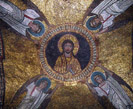Carl Jung Resources > Mandala
Jung and Mandala Mandala is a graphical representation of the center (the Self at Jung). It can appear in dreams and visions or it can be created spontaneously as by drawing. It is present in the cultural and religious representations.
In yoga practices, mandala can be a support for meditation or an image that must be internalized through mental absorption. This image organizes the inner energies and forces of the practitioner and puts them in relationship with his ego-consciousness. Generally speaking a mandala is a geometrical form - a square or a circle - abstract and static, or a vivid image formed of objects and/or beings. In our dreams, the mandala indicates the phenomenon of centering of the ego in relation with the psychic wholeness. It is part of the individuation process as described by Jung in his works.In modern dreams mandala can be a sophisticated electronic device: an electronic watch or a sophisticated circular machinery. Often the UFOs seen in the sky or in dreams are also mandalas. Other mandala images can be circular fountains, parks and their radial alleys, square market places, obelisks, buildings with a circular or square shape, lakes, rivers (radial water networks).
There are a lot of illustrations that testify this technique practiced by Jung himself. -- In 1938, I had the opportunity, in the monastery of Bhutia Busty, near Darjeeling, of talking with a Lamaic rimpoche, Lingdam Gomchen by name, about the khilkor or mandala. He explained it as a dmigs-pa (pronounced ''migpa"), a mental image which can be built up only by a fully instructed lama through the power of imagination. He said that no mandala is like any other, they are all individually different. Also, he said, the mandalas to be found in monasteries and temples were of no particular significance because they were external representations only. The true mandala is always an inner image, which is gradually built up through (active) imagination, at such times when psychic equilibrium is disturbed or when a thought cannot be found and must be sought for, because it is not contained in holy doctrine. (Psychology and Alchemy, Princeton University Press, 1993, paragraph 123.)It seems to me beyond question that these Eastern symbols originated in dreams and visions, and were not invented by some Mahayana church father. (Psychology and Alchemy, Paragraph 124.) It is not without importance for us to appreciate the high value set upon the mandala, for it accords very well with the paramount significance of individual mandala symbols which are characterized by the same qualities of a - so to speak - "metaphysical" nature. Unless everything deceives us, they signify nothing less than a specific centre of the personality not to be identified with the ego. (Psychology and Alchemy, Paragraph 126.)
See also:
Further Resources:
|
©AROPA, 2025.

